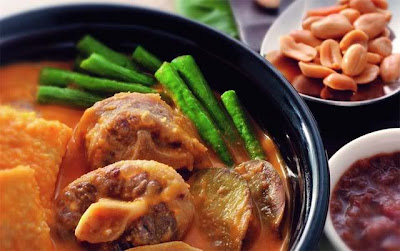by Luz De Dios Tañedo
Kare Kare is a peanut-based stew with vegetables and meat. Beef and Pork are the most common meat used for this dish but Oxtail and sometimes Tripe are used or a combination of both. It is usually served with Bagoong - a salty condiment made of small alamang (shrimp)pickled in brine, sautéed with onions and garlic to enhance the flavor.
- 1 kilo Ox tail (2.2 lbs)
- 10 pieces of sitaw (long beans)
- 3 pieces of long eggplants - cut into pieces
- 1 bundle of pechay (bok choy)
- 1 large banana heart cut into quarters
- 3 tablespoons of achuete
- 2 cups of roasted peanuts (crushed)*
- 1 large onion
- 5 cloves of minced garlic
- Bagoong*
- Salt
Directions:
- Boil Ox tail until tender - 45 minutes if using dutch pan or 30 minutes if using pressure cooker
- Sauté garlic, onions, and achuete until garlic is golden brown
- Add Ox tail and half of the oxtail broth. Lower heat and let it simmer for 15 minutes.
- Add crushed peanuts and mix with the broth
- Add eggplants, long beans, banana heart, and pechay. Cover and let it simmer for 10 minutes
- Add salt to taste*
Preparation time: 30 minutes
Cooking time: 60 minutes
Serving: 4-6 people
Tips
* If roasted peanuts are not available, peanut butter may be used as an alternative.
* Because bagoong is used as a condiment and has a very salty flavor, salt can be skipped altogether.
Food for thought:
Bagoong Alamang (Shrimp Paste)
 Shrimp paste or shrimp sauce, is a common ingredient used in Southeast Asian and Southern Chinese cuisine. It is known as terasi (also spelled trassi, terasie) in Indonesian, ngapi (ငါးပိ, IPA: [ŋəpi̯]) in Burmese, kapi (กะปิ) in Thai, Khmer and Lao language, belacan (also spelled belachan, blachang) in Malay, mắm ruốc, mắm tép and mắm tôm in Vietnamese (the name depends on the shrimp used), bagoong alamang (also known as bagoong aramang) in Filipino, haam ha/ha jeung in Cantonese Chinese and hom ha/hae ko (POJ: hê-ko) in Min Nan Chinese. see more...
Shrimp paste or shrimp sauce, is a common ingredient used in Southeast Asian and Southern Chinese cuisine. It is known as terasi (also spelled trassi, terasie) in Indonesian, ngapi (ငါးပိ, IPA: [ŋəpi̯]) in Burmese, kapi (กะปิ) in Thai, Khmer and Lao language, belacan (also spelled belachan, blachang) in Malay, mắm ruốc, mắm tép and mắm tôm in Vietnamese (the name depends on the shrimp used), bagoong alamang (also known as bagoong aramang) in Filipino, haam ha/ha jeung in Cantonese Chinese and hom ha/hae ko (POJ: hê-ko) in Min Nan Chinese. see more...Shrimp paste or shrimp sauce, is a common ingredient used in Southeast Asian and Southern Chinese cuisine. It is known as terasi (also spelled trassi, terasie) in Indonesian, ngapi
(ငါးပိ, IPA: [ŋəpi̯]) in Burmese, kapi (กะปิ) in Thai, Khmer and Lao language, belacan (also spelled belachan, blachang) in Malay, mắm ruốc, mắm tép and mắm tôm in Vietnamese (the name depends on the shrimp used), bagoong alamang (also known as bagoong aramang) in Filipino, haam ha/ha jeung in Cantonese Chinese and hom ha/hae ko (POJ: hê-ko) in Min Nan Chinese. see more...
Puso ng Saging
 Puso ng saging literally translated is “heart of banana.” Most English source books however, refer to this common “vegetable” as Banana bud, flower or blossom… I have no idea why the cooked puso is considered a vegetable while the fruit of the same tree is a fruit… I suppose if you ate a salad of apple leaves that would be a vegetable too… At any rate, puso is the brilliantly maroon or red end of a bunch of bananas. It is extremely common because banana trees (a large herb, actually) grow by the gajillions in the Philippine countryside… see more
Puso ng saging literally translated is “heart of banana.” Most English source books however, refer to this common “vegetable” as Banana bud, flower or blossom… I have no idea why the cooked puso is considered a vegetable while the fruit of the same tree is a fruit… I suppose if you ate a salad of apple leaves that would be a vegetable too… At any rate, puso is the brilliantly maroon or red end of a bunch of bananas. It is extremely common because banana trees (a large herb, actually) grow by the gajillions in the Philippine countryside… see moreAtsuete/Achuete (Annato) Biva orillana Linon
 Next to caramel, annatto is the world's most important natural colorant yielding yello to red colors. There is global commercial production of the seed, estimated in 1990 at 10,000 tons per year; Brazil being the largest exported.
Next to caramel, annatto is the world's most important natural colorant yielding yello to red colors. There is global commercial production of the seed, estimated in 1990 at 10,000 tons per year; Brazil being the largest exported.A tree reaching 4 to 6 meters. Leaves are entire, ovate, 8 to 20 cm long, 5 to 12 cm wide, with a broad and heart-shaped base, and a pointed tip. The flowers are white or pinkish, 4 to 6 cm diameter, 4 to 6 cm in diameter on terminal panicles. Capsules are ovoid or rounded, reddish brown, about 4 cm long and covered with long, slender and soft spines containing many small seeds covered with a dye-yielding red pulp. see more...


